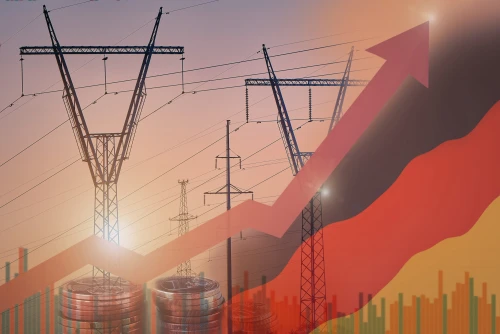
April 25th, 2025
Join our Italian Energy Day on 20 May – Book now
We explore how financial models are used to evaluate PPAs, focusing on key metrics, analysis methods, and best practices.

Power Purchase Agreements (PPAs) are essential tools in the renewable energy sector, providing a stable revenue stream by locking in buyers for the energy produced. However, evaluating these long-term contracts requires careful financial analysis to determine their profitability and manage risks. Financial models play a crucial role in assessing the viability and success of PPA agreements for renewable projects.
A Power Purchase Agreement (PPA) is a long-term contract between an energy provider and a buyer, typically lasting 10 to 25 years. PPAs guarantee that the buyer will purchase energy at a predetermined rate, creating a predictable income for renewable energy projects. This financial stability is crucial in an industry where upfront costs are high, but revenue can be uncertain due to factors like market fluctuations and evolving regulations.
PPAs are particularly valuable for renewable projects, such as solar and wind farms, because they enable projects to secure financing. The guaranteed income allows project developers to attract investors by demonstrating financial viability. However, evaluating whether a PPA is profitable over the long term requires a robust financial model to account for risks, costs, and projected returns.
EU European Electricity Market Summary
Our expert analysis of key trends, challenges, and milestones shaping Europe’s electricity market in 2024
Financial models are used to forecast the economic outcomes of PPAs by analysing cash flows, costs, revenue, and risks. These models help investors and project developers make data-driven decisions, ensuring that the contract aligns with financial goals. By examining financial models, stakeholders can gain insights into the project’s profitability, payback period, and risk profile.
Financial models provide several benefits when evaluating PPAs:
Determines whether the project will generate the expected returns.
Identifies potential risks and evaluates their impact on the project's financial health.
Assesses whether the project can remain profitable under changing market conditions.
When evaluating a PPA for a renewable project, several key metrics are essential for understanding the financial picture.
Cash flow analysis examines all inflows and outflows associated with the project over the contract's duration. It considers initial investments, ongoing operational costs, and revenue generated by the PPA. By forecasting cash flows, stakeholders can determine whether the project will maintain positive cash flow and avoid liquidity issues over time.
The Net Present Value (NPV) is a critical metric in evaluating PPAs. NPV calculates the present value of future cash flows, discounted by a specific rate, usually the cost of capital. A positive NPV indicates that the project is expected to be profitable, while a negative NPV suggests it may not generate adequate returns. For renewable projects, NPV is vital as it considers the time value of money, ensuring that future revenue adequately compensates for the initial investment.
Internal Rate of Return (IRR) measures the expected rate of return on a project. It is the discount rate at which the NPV of future cash flows equals zero. IRR is commonly used to compare the profitability of different projects or to assess whether a project meets an investor’s required rate of return. In the context of PPAs, a high IRR indicates that the project is likely to be financially successful and attractive to investors.
The payback period is the time required to recoup the initial investment. For renewable energy projects, which often have high upfront costs, understanding the payback period is crucial. A shorter payback period suggests that the project will start generating profits sooner, which can make it more attractive to investors.
Creating an effective financial model for a PPA requires careful consideration of several factors, including costs, revenue, and assumptions about future conditions.
The first step is gathering accurate data and setting realistic assumptions. Key inputs include:
Initial cost of building the project.
Ongoing costs, including maintenance and operations.
Expected revenue from the PPA, based on the agreed-upon price and projected energy production.
The cost of capital or the rate at which future cash flows are discounted.
Projected increases in costs and PPA prices over time.
Once data and assumptions are in place, the model forecasts annual cash flows. This forecast includes expected revenue, expenses, and tax implications over the contract period. Cash flow forecasts help determine whether the project will generate positive cash flow and achieve financial targets.
Using the forecasted cash flows, calculate the NPV, IRR, and payback period. These metrics will help assess whether the project is financially viable and meets investment criteria.
Renewable projects face various risks that can impact their financial success. Financial models should include a risk assessment to help stakeholders prepare for potential issues.
Market Risks: Fluctuations in energy prices can affect project revenue, especially for PPAs with variable pricing structures.
Regulatory Risks: Changes in government policies, tax incentives, or environmental regulations can impact project profitability.
Operational Risks: Equipment failures or suboptimal energy production can reduce project revenue and increase costs.
Environmental Risks: Natural events, such as extreme weather conditions, can disrupt operations and impact financial performance.
To account for these risks, financial models should incorporate sensitivity analysis, which tests how changes in key variables impact project profitability. For example, the model can show the impact of lower-than-expected energy production or increased maintenance costs. Scenario analysis, which considers best-case, worst-case, and most likely scenarios, is another useful tool for understanding how different situations may affect project outcomes.
Regularly updating financial models ensures they reflect current market conditions and regulations. This helps stakeholders make timely adjustments to project expectations and strategies.
Scenario and sensitivity analyses provide a clearer picture of potential outcomes. By evaluating different scenarios, stakeholders can make more informed decisions and better prepare for uncertainties.
Incorporating Environmental, Social, and Governance (ESG) factors is becoming increasingly important in renewable project evaluations. Projects that align with ESG criteria may attract additional investors and achieve long-term sustainability.
Evaluating PPAs for renewable projects requires a solid financial model that considers cash flows, risks, and profitability metrics. By using financial models to assess PPAs, stakeholders can make data-driven decisions, minimise risks, and maximise returns on investment. From cash flow analysis to risk assessment, financial modelling plays a crucial role in ensuring the success and sustainability of renewable energy projects. As the renewable energy industry grows, robust financial evaluation will remain essential for aligning environmental goals with profitable business outcomes.
We help you learn the market, find contract partners and sign PPAs

April 25th, 2025

April 24th, 2025

April 23rd, 2025